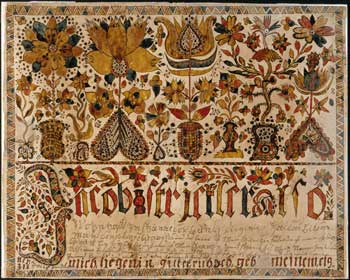The Arts of the
Pennsylvania Germans
By the time of the first United States census in 1790, German-Swiss settlers made up one third of the population in Pennsylvania, and nearly forty percent in the southeastern region of the state. Often incorrectly called Pennsylvania Dutch, a misunderstanding of the word Deutsch (German), these settlers brought with them the artistic traditions of their native land. Slat-back side chairs and painted chests derived their simple, easily constructed form and ornament from vernacular furniture in Germany and the Netherlands. The birth and marriage certificates known as fraktur continued a long-standing German tradition of embellishing important documents with hearts, tulips, birds, unicorns, and other colorful designs.
Early in the twentieth century, enterprising dealers and collectors "discovered" the aesthetic beauty and accomplishments represented in many of the objects these Germanic settlers produced. Although Henry Francis du Pont was first smitten by historic New England objects, when he returned to the Delaware Valley from a trip North in 1923, he began to acquire objects produced centuries before in his own "backyard," Pennsylvania.


